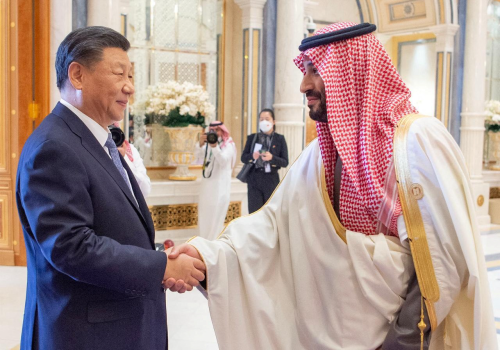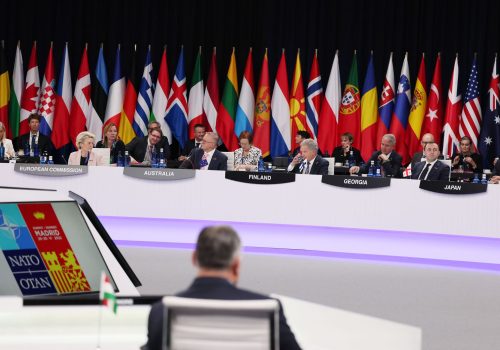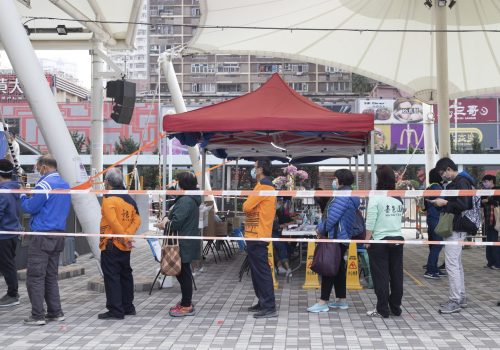The balloon drama was a drill. Here’s how the US and China can prepare for a real crisis.
The Chinese surveillance balloon incident highlighted a central problem for Washington and especially Beijing: the need for their leaders to talk tough in public while retaining the opportunity to seek progress—or prevent worse—in private. This was hard in 2001, when the Chinese held twenty-four crew members of a US EP-3 reconnaissance aircraft that made an emergency landing on China’s Hainan Island after a Chinese fighter collided with it in international airspace, resulting in the loss of the Chinese pilot. Then, the United States skillfully used public rhetoric and private diplomatic and military dialogue to give Chinese President Jiang Zemin a path to resolution just eleven days after the airborne collision. Today, that kind of deft solution is far less likely. The two nations’ communication breakdown could prove disastrous if a crisis arises that’s bigger than a balloon—which is why they need to start talking now.
The parallels to 2001 go beyond the fact that the surveillance balloon was launched from Hainan Island. Indeed, in the first statement on the balloon issued by the Chinese foreign ministry, one can hear echoes of US President George W. Bush’s 2001 statement of regret—short of the apology that Jiang had publicly demanded:
“I regret that a Chinese pilot is missing. Our prayers go out to the pilot, his family. Our prayers are also with our own servicemen and women, and they need to come home… Our relationship with China is very important, and—but they need to realize that it’s time for our people [to] be home.” —Remarks by President Bush, April 5, 2001
“The airship is from China. It is a civilian airship used for research, mainly meteorological, purposes. Affected by the Westerlies and with limited self-steering capability, the airship deviated far from its planned course. The Chinese side regrets the unintended entry of the airship into US airspace due to force majeure.” —Chinese Ministry of Foreign Affairs statement, February 2, 2023
But in the more recent case, the United States was still building an understanding of what had happened, as new revelations of past and ongoing Chinese surveillance balloons surfaced daily in the US media. Washington was not prepared to publicly reciprocate until after a US Air Force F-22 shot the balloon down over the Atlantic Ocean on February 4. Once President Joe Biden had demonstrated resolve by ordering the shootdown, and after US air defenders spent the next week chasing floating objects—likely hobbyist balloons—across North American skies, unnamed administration officials acknowledged Beijing’s initial claim that unusual upper-level winds and rare polar vortices may have been responsible for the balloon’s path, rather than Chinese recklessness.
Nonetheless, it’s clear today that China’s high-altitude balloon surveillance is significant, with operations dating since at least 2018. One question this raises is: What additional intelligence could China gain from high-altitude overflight of the continental United States, Hawaii, Guam, or US bases in Japan? After all, China is a major spacefaring power that, according to the most recent Department of Defense annual report to Congress on the Chinese military, has some 260 military or intelligence satellites in orbit. Experts have noted that high-altitude balloon collection could benefit China’s investment in hypersonic weapons or improve the accuracy of its rapidly expanding intercontinental ballistic missile force. But there’s likely also a political dynamic. From Beijing’s perspective, the United States flies numerous intelligence collection aircraft on China’s periphery, especially over the South China Sea and off its east coast. The United States strictly abides by international law and does not violate China’s twelve-mile limit over its airspace. But this has long been a sore point for Beijing and could have led China to send high-altitude balloons near or over the United States as a way to reciprocate.
Seeds of another Cuban Missile Crisis
As the balloon episode demonstrated, it is much harder today for Beijing and Washington to untangle a serious incident, even without the loss of life and detention of twenty-four US service members that greatly complicated the 2001 affair. At the time of Bush’s crisis, he was barely two months into his administration after a bruising election outcome resolved in his favor by the US Supreme Court. It also was the first interaction with China for his new national security team, many of whom had been critical of China during the presidential election campaign. This made the stakes unusually high for China’s Jiang, who had been seeking a reset in relations that were severely disrupted by the accidental US bombing of China’s embassy in Belgrade in 1999, which killed three Chinese nationals. Jiang could not be seen as backing down to the United States unless Washington offered him a face-saving way to resolve the impasse. Bush’s non-apology statement of regret opened the door to resolution. In the next nineteen months, the two leaders would meet twice—at the Asia-Pacific Economic Cooperation (APEC) Summit hosted by Jiang in Shanghai just weeks after the September 11 attacks on the United States, and a year later when Bush hosted Jiang at his ranch in Crawford, Texas.
The most critical goal should be to avoid having to create communications in the midst of an actual crisis.
Today, the regular communication channels and personal familiarity between senior US and People’s Republic of China (PRC) officials have broken down. The two sides depend to a dangerous degree on direct, irregular conversations between Biden and Chinese leader Xi Jinping. Even worse is when the two leaders talk to each other in public through the media and, therefore, are more focused on domestic audiences and their bottomless appetite to show resolve and thrust the burden for resolution on the other side. Much of the fault for this falls on Beijing’s shoulders since it frequently retaliates for events such as then US House Speaker Nancy Pelosi’s August 2022 visit to Taiwan by further curtailing even meager scheduled security dialogue. This reinforces the current dynamic that all initiatives must percolate from the top down, rather than from the bottom up, a reversal of normal productive diplomacy and crisis communication.
Washington’s goal now should be to take advantage of the balloon incident not only to prevent recurrences, but also to rebuild critical communication pathways. The main lesson to be drawn so far is that US-China strategic rivalry overshadows the practice of effective diplomacy and, in a real crisis, public opinions and partisan rancor (on the United States’ side) will tend to accelerate escalation well before the facts can be ascertained by either side. The most critical goal should be to avoid having to create communications in the midst of an actual crisis. Otherwise, as the balloon incident demonstrates, it is only a matter of when, not if, a serious crisis descends to something far worse—perhaps a Gulf of Tonkin situation on steroids, more reminiscent of the Cuban Missile Crisis than any other incident in recent US-PRC relations.
The United States—aided by allies and partners, who have largely maintained regular diplomatic and security dialogue with China—must build on its successful management and, for now, resolution of the mini-crisis caused by China’s balloon surveillance over the United States. Regular, official meetings at appropriate levels are not a favor that the United States grants China for good behavior. Rather than meetings for meetings’ sake, they ensure that US officials are heard directly, not filtered via the US or Chinese press. They expand direct personal knowledge of counterparts, which will be even more important with pending senior Chinese government personnel changes in early March. And most importantly, they provide a basis for regular interactions even in the case of new incidents.
The next flashpoints
This year and next will see significant events that can further deepen misunderstanding and increase the prospect for serious crises—even beyond the potential volatility of the Taiwanese and US elections in 2024, or the chance that China again, errantly or otherwise, penetrates US air space with another surveillance balloon. For example:
- Taiwan President Tsai Ing-wen has been invited to attend a summit of Taiwan’s international friends and few remaining diplomatic partners next month in Guatemala. To do so, she probably would transit the United States, and the Taiwanese press has reported that she may visit Cornell University in New York (her law school alma mater). It was a visit to Cornell in 1995 by the then president, Lee Teng-hui, that precipitated the last major US military crisis with China.
- US House Speaker Kevin McCarthy may fulfill his pledge to visit Taiwan later this year. China greatly resented Pelosi’s visit last August and responded by conducting missile launches surrounding Taiwan and increased air incursions into Taiwan’s self-declared air defense identification zone. Its response to another speaker visit is likely to exceed its 2022 response, which was itself unprecedented.
All of this argues strongly for Beijing and Washington to reestablish regular formal contacts to expand capacity for direct conversations in the event of increased tensions, and the possibility of major crises. The alternative is even greater miscalculation, potentially under circumstances where the stakes are even higher.
John K. Culver is a nonresident senior fellow with the Atlantic Council’s Global China Hub and a former Central Intelligence Agency senior intelligence officer with thirty-five years of experience as a leading analyst of East Asian affairs, including security, economic, and foreign-policy dimensions.
Further reading
Wed, Feb 15, 2023
Full throttle in neutral: China’s new security architecture for the Middle East
Issue Brief By Tuvia Gering
This report addresses two widely held beliefs about the nature of China’s engagement in the Middle East and North Africa (MENA) that ought to be revisited in light of notable developments. First, while it is widely assumed that Beijing’s interests in the region are limited to energy security and economic ties, this report will show how cooperation has […]
Thu, Feb 2, 2023
Implementing NATO’s Strategic Concept on China
Report By
Allies made it clear that they consider Russia their most immediate and direct threat. Yet they also made headlines by addressing challenges emanating from the People’s Republic of China (PRC).
Wed, Feb 8, 2023
China Pathfinder: H2 2022 update
Issue Brief By
In the second half of 2022, China veered from one extreme to the other, with carefully choreographed control followed by sudden turmoil. Nevertheless, China’s economic weakness is pushing leadership to strike a more business-friendly tone.
Image: The suspected Chinese spy balloon drifts to the ocean after being shot down off the coast in Surfside Beach, South Carolina, U.S. February 4, 2023.


